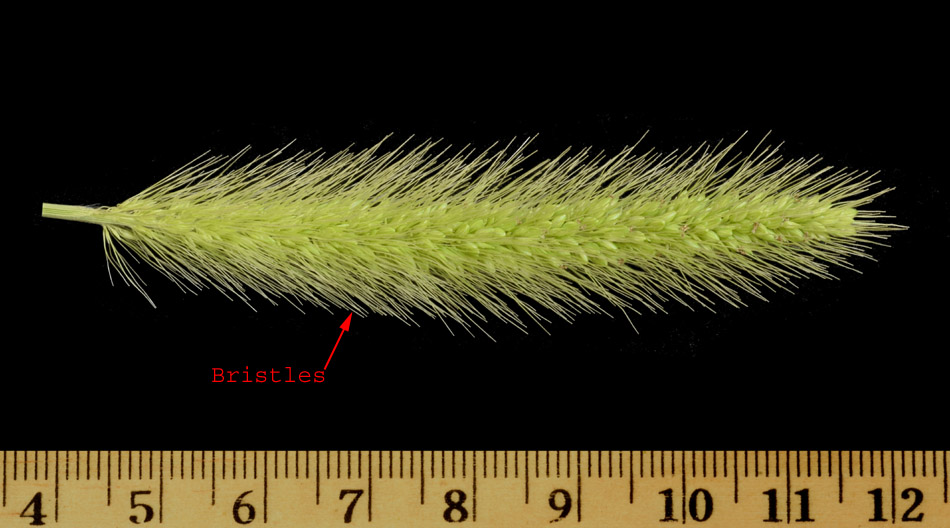Setaria viridis

Green Foxtail
Inflorescence
Crooked
Lake Provincial Park
06-July-2023
The inflorescence is a contracted panicle which
appears spike-like.
The following items are taken from keys in Flora
of Saskatchewan, Fascicle 4, Grasses of Saskatchewan by Anna L. Leighton and
Vernon L. Harms. Family Poaceae is first divided into tribes, then the
tribes are divided into genera, and the genera divided into species.
However, there are a number of tribes that are very difficult to distinguish
morphologically. These are grouped into a large, artificial tribe I call
"Multitribe". Multitribe is then divided into groups, and each
group is then divided into genera. The answers are in the order you would
normally work through the keys.
 |
Paniceae: Answers to key questions
leading to this tribe.
 | Mature inflorescence, if breaking into units, then the units not as
below; NOT [Mature inflorescence breaking into spikelet units consisting
of a sessile fertile spikelet, a hairy pedicel with or without a sterile
spikelet at tip, and a hairy rachis joint, all arising at the same point
(a node) in specialized panicle branches called rames] |
 | Spikelets usually
dorsally compressed, appearing 1-flowered but containing 1 fertile
floret and 1 sterile floret, the latter attached to the base of fertile
floret opposite the upper glume, resembling the upper glume, and
together with the upper glume enveloping the fertile floret; lower
glumes minute (sometimes absent) to 3/4 as long as upper glumes and
typically wrapping most of the way around the pedicel at base; fertile
floret seed-like with chartaceous-indurate lemma and palea enclosing
flower and fruit; disarticulation below the glumes with rare exceptions; NOT
[Spikelets not as above; sterile florets if present, either located
distal to the fertile floret(s) on the rachilla or paired and attached
at the base of a single fertile floret, not paired with the upper glume
as above; lemma and palea variously textured, enclosing the flower or
not; disarticulation usually above the glumes]
|
|
 |
Setaria: Answers to key questions
leading to this genus (in tribe Paniceae).
 | Spikelets with bristles attached in groups at base; panicle dense and
spike-like; NOT [Spikelets lacking bristles but rachis and pedicels may
have scattered, long, papillose-based hairs; panicle not spike-like]
|
 |
Curtiseta: Answers to key questions
leading to this species (in genus
Setaria).
 | Upper glumes about as long as the spikelet and mostly covering the
inconspicuously transversely rugose lemma surface of the fertile floret;
spikelets 1.8-2.2 mm long; bristles in groups of 1-3, usually green,
purplish or tawny; leaf blades glabrous; leaf sheath margins long
pubescent or ciliate distally; sterile florets lacking stamens, reduced
to a lemma and a vestigial palea about 1/3 as long as lemma, or absent;
NOT [Upper glumes about 1/2 as long as the spikelet and revealing the
conspicuously transversely rugose lemma surface of the fertile floret;
spikelets 2-3.5 mm long; bristles usually in groups of 4 or more,
maturing to distinctive golden yellow to brownish yellow; leaf blades
long villose at base on adaxial surface and sometimes pilose distally;
leaf sheath margins not ciliate or pubescent distally; sterile florets
usually staminate, their paleas well developed, about as long as the
lemma]
|
|
|

